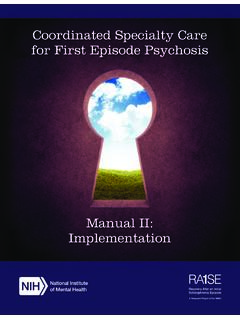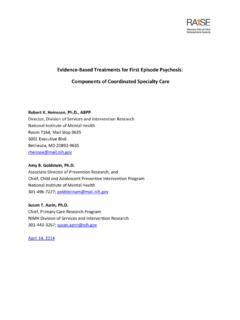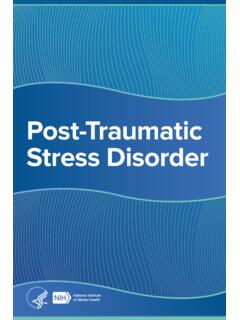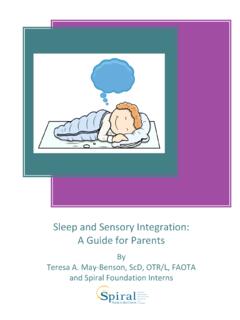Transcription of Autism Spectrum Disorder
1 Autism Spectrum DisorderNational Instituteof Mental HealthWhat is Autism Spectrum Disorder ? Autism Spectrum Disorder (ASD) is a developmental Disorder that affects communication and behavior. Although Autism can be diagnosed at any age, it is described as a developmental Disorder because symptoms generally appear in the first two years of life. According to the Diagnostic and Statistical Manual of Mental Disorders (DSM-5), a guide created by the American Psychiatric Association used to diagnose mental disorders, people with ASD have: Difficulty with communication and interaction with other people Restricted interests and repetitive behaviors Symptoms that affect the person s ability to function in school, work, and other areas of lifeAutism is known as a Spectrum Disorder because there is wide variation in the type and severity of symptoms people experience.
2 ASD occurs in all ethnic, racial, and economic groups. Although ASD can be a lifelong Disorder , treatments and services can improve a person s symptoms and ability to function. The American Academy of Pediatrics recommends that all children be screened for Autism . All caregivers should talk to their child s doctor about ASD screening or are the signs and symptoms of ASD?People with ASD have difficulty with social communication and interaction and have restricted interests and repetitive behaviors. The list below gives some examples of the types of behaviors that are common in people diagnosed with ASD.
3 Not all people with ASD will have all behaviors, but most will have several of the behaviors listed communication/interaction behaviors may include: Making little or inconsistent eye contact Having a tendency not to look at or listen to people Rarely sharing enjoyment of objects or activities by pointing at or showing things to others Failing to, or being slow to, respond to someone calling their name or to other verbal attempts to gain attention Having difficulties with the back and forth of conversation Often talking at length about a favorite subject without noticing that others are not interested or without giving others a chance to respond Having facial expressions, movements.
4 And gestures that do not match what is being said Having an unusual tone of voice that may sound sing-song or flat and robot-like Having trouble understanding another person s point of view or being unable to predict or understand other people s actionsRestrictive/repetitive behaviors may include: Repeating certain behaviors or having unusual behaviors, such as repeating words or phrases (a behavior called echolalia) Having a lasting intense interest in certain topics, such as numbers, details, or facts Having overly focused interests, such as with moving objects or with parts of objects Getting upset by slight changes in a routine Being more sensitive or less sensitive than other people to sensory input, such as light, noise, clothing, or temperaturePeople with ASD may also experience sleep problems and irritability.
5 Although people with ASD experience many challenges, they may also have many strengths, including: Being able to learn things in detail and remember information for long periods of time Being strong visual and auditory learners Excelling in math, science, music, or artWhat are the causes and risk factors for ASD?Researchers don t know the exact causes of ASD, but studies suggest that genes can act together with influences from the environment to affect development in ways that lead to ASD. Although scientists are still trying to understand why some people develop ASD and others don t, some factors that increase the risk of developing ASD include: Having a sibling with ASD Having older parents Having certain genetic conditions (For example, people with conditions such as Down syndrome, fragile X syndrome, and Rett syndrome are more likely than others to have ASD.)
6 Being born with a very low birth weightNot everyone who has these risk factors develops ASD. How is ASD diagnosed?Doctors diagnose ASD by looking at a person s behavior and development. ASD can usually be reliably diagnosed by the age of two. It is important for those with concerns to seek out an assessment as soon as possible so that a diagnosis can be made, and treatment can begin. Diagnosis in Young ChildrenDiagnosis in young children is often a two-stage 1: General Developmental Screening During Well-Child CheckupsEvery child should receive well-child checkups with a pediatrician or an early childhood health care provider.
7 The American Academy of Pediatrics recommends that all children be screened for developmental delays at their 9-, 18-, and 24- or 30-month well-child visits, and specifically for Autism at their 18- and 24-month well-child visits. Additional screenings might be needed if a child is at high risk for ASD or developmental problems. Children at high risk include those who have a family member with ASD, have some ASD behaviors, have older parents , have certain genetic conditions, or who were born at a very low birth experiences and concerns are very important in the screening process for young children.
8 Sometimes the doctor will ask parents questions about their child s behaviors and combine those answers with information from ASD screening tools and with his or her observations of the child. To read more about ASD screening tools, visit the Centers for Disease Control and Prevention s (CDC) website at who show developmental differences during this screening process will be referred for a second stage of 2: Additional EvaluationThis second evaluation is with a team of doctors and other health professionals who are experienced in diagnosing ASD. This team may include: A developmental pediatrician a doctor who has special training in child development A child psychologist and/or child psychiatrist a doctor who has specialized training in brain development and behavior A neuropsychologist a doctor who focuses on evaluating, diagnosing, and treating neurological, medical, and neurodevelopmental disorders A speech-language pathologist a health professional who has special training in communication difficultiesThis second evaluation may assess.
9 Cognitive level or thinking skills Language abilities Age-appropriate skills needed to complete daily activities independently, such as eating, dressing, and toiletingBecause ASD is a complex Disorder that sometimes occurs along with other illnesses or learning disorders, the comprehensive evaluation may include blood tests and a hearing test. The outcome of this evaluation will result in a formal diagnosis and recommendations for in Older Children and AdolescentsASD symptoms in older children and adolescents who attend school are often first recognized by parents and teachers and then evaluated by the school s special education team.
10 The school s team may perform an initial evaluation and then recommend these children visit their primary health care doctor or a doctor who specializes in ASD for additional testing. parents may talk with these doctors about their child s social difficulties, including problems with subtle communication. These subtle communication issues may include problems understanding tone of voice, facial expressions, or body language. Older children and adolescents may have trouble understanding figures of speech, humor, or sarcasm. parents may also find that their child has trouble forming friendships with peers.










